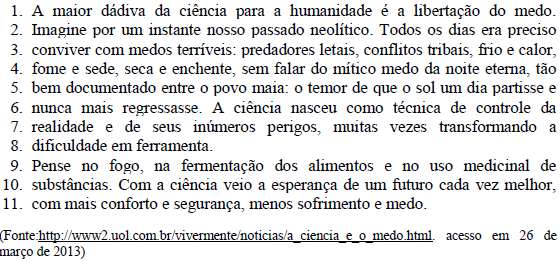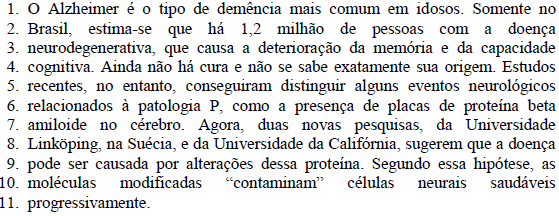Questões Militares
Para exército
Foram encontradas 21.017 questões
Resolva questões gratuitamente!
Junte-se a mais de 4 milhões de concurseiros!
I learnt to fly in a balloon in a race across the Atlantic Ocean in 1992 and became fascinated by the sport. In the same way that a mountain climber dreams of climbing the world's highest mountain, I dreamed about flying non-stop around the world.
I spent six years planning the flight and failed twice before we managed to succeed. Our route took us over China, but we could only get permission to travel over the south. This meant going first to North Africa to catch the right winds. That added 10,000 kilometers, and another week, to our journey. But because of this, our flight broke all the records for distance and time spent in the air.
My main memory of the trip is that we lived in the air for 20 days and the rising sun was the most amazing thing we saw. We had to go out of the balloon's capsule, in which we were transported, three times while in the air to repair the fuel system. We didn't have any safety equipment but when you are in a situation like that, you just do what you have to do without thinking about feeling afraid.
Landing was a fantastic moment. I remember when I got out of the capsule, I looked at my footprint in the sand. I remembered the astronaut Neil Armstrong who was so happy to put his footprint on the moon, so far away from Earth. At that moment, I was so happy to have my foot back on Earth!
(Fonte: Original)
What was the newspaper headline after the balloon landed?
I learnt to fly in a balloon in a race across the Atlantic Ocean in 1992 and became fascinated by the sport. In the same way that a mountain climber dreams of climbing the world's highest mountain, I dreamed about flying non-stop around the world.
I spent six years planning the flight and failed twice before we managed to succeed. Our route took us over China, but we could only get permission to travel over the south. This meant going first to North Africa to catch the right winds. That added 10,000 kilometers, and another week, to our journey. But because of this, our flight broke all the records for distance and time spent in the air.
My main memory of the trip is that we lived in the air for 20 days and the rising sun was the most amazing thing we saw. We had to go out of the balloon's capsule, in which we were transported, three times while in the air to repair the fuel system. We didn't have any safety equipment but when you are in a situation like that, you just do what you have to do without thinking about feeling afraid.
Landing was a fantastic moment. I remember when I got out of the capsule, I looked at my footprint in the sand. I remembered the astronaut Neil Armstrong who was so happy to put his footprint on the moon, so far away from Earth. At that moment, I was so happy to have my foot back on Earth!
(Fonte: Original)
Why did the pilots get out of the capsule during the flight?
I learnt to fly in a balloon in a race across the Atlantic Ocean in 1992 and became fascinated by the sport. In the same way that a mountain climber dreams of climbing the world's highest mountain, I dreamed about flying non-stop around the world.
I spent six years planning the flight and failed twice before we managed to succeed. Our route took us over China, but we could only get permission to travel over the south. This meant going first to North Africa to catch the right winds. That added 10,000 kilometers, and another week, to our journey. But because of this, our flight broke all the records for distance and time spent in the air.
My main memory of the trip is that we lived in the air for 20 days and the rising sun was the most amazing thing we saw. We had to go out of the balloon's capsule, in which we were transported, three times while in the air to repair the fuel system. We didn't have any safety equipment but when you are in a situation like that, you just do what you have to do without thinking about feeling afraid.
Landing was a fantastic moment. I remember when I got out of the capsule, I looked at my footprint in the sand. I remembered the astronaut Neil Armstrong who was so happy to put his footprint on the moon, so far away from Earth. At that moment, I was so happy to have my foot back on Earth!
(Fonte: Original)
Why did the balloon fly over south China?
I learnt to fly in a balloon in a race across the Atlantic Ocean in 1992 and became fascinated by the sport. In the same way that a mountain climber dreams of climbing the world's highest mountain, I dreamed about flying non-stop around the world.
I spent six years planning the flight and failed twice before we managed to succeed. Our route took us over China, but we could only get permission to travel over the south. This meant going first to North Africa to catch the right winds. That added 10,000 kilometers, and another week, to our journey. But because of this, our flight broke all the records for distance and time spent in the air.
My main memory of the trip is that we lived in the air for 20 days and the rising sun was the most amazing thing we saw. We had to go out of the balloon's capsule, in which we were transported, three times while in the air to repair the fuel system. We didn't have any safety equipment but when you are in a situation like that, you just do what you have to do without thinking about feeling afraid.
Landing was a fantastic moment. I remember when I got out of the capsule, I looked at my footprint in the sand. I remembered the astronaut Neil Armstrong who was so happy to put his footprint on the moon, so far away from Earth. At that moment, I was so happy to have my foot back on Earth!
(Fonte: Original)
What's Piccard's main reason for writing this text?
I remember ____ names, but they don't remember ______. ______ name is Ana and _____ name is David. I told ______ that ______ name is Carlos.

Analise as afirmativas abaixo e, a seguir, assinale a alternativa correta.

“demência" (l.1) em relação a “Alzheimer" (l.1) estabelece uma relação de:
“O _______ de peso é um problema para muitas pessoas ______, para os ursos polares, pode ser a solução. Um novo estudo publicado na última semana na revista científica Journal of Animal Ecology mostra que o alarmante ________ no Ártico está modificando os hábitos dos ursos polares e, com mais dificuldade para conseguir alimentos, apenas aqueles que têm mais gordura ____________ sobreviver"
(Fonte: http://colunas.revistaepoca.globo.com/planeta/2013.... Acesso em: 26 de março de 2013)
I. Crítico às fraudes eleitorais e ao domínio das oligarquias, o Tenentismo pautou-se pela defesa de uma democracia ampla no País.
II. Contrário ao domínio das oligarquias, o Tenentismo transitou progressivamente de uma conduta de caráter corporativo para a defesa crescente de propostas de transformação política para o País.
III. Apesar de críticos do sistema político vigente, os tenentes rebeldes da década de 1920 mantiveram uma conduta de neutralidade quando do golpe de Estado que levou Getúlio Vargas ao poder em 1930.
I. O texto constitucional considerou sagrada, inviolável e irresponsável a pessoa do Imperador.
II. A constitucionalização da nação brasileira foi uma decorrência do respeito do Imperador à Assembléia Constituinte que se incumbiu da elaboração da Carta.
III. A Constituição estabeleceu que todos os portugueses residentes no Brasil naquele momento seriam considerados brasileiros.
I. Entre as motivações para a criação do sistema administrativo de governo geral nas possessões portuguesas da América estava o risco de perda de parte do território para os franceses.
II. A criação do sistema de capitanias hereditárias, implantado na América portuguesa durante a década de 1530, foi uma decisão que provocou um acelerado crescimento populacional e produtivo na região em poucas décadas.
III. Entre as prerrogativas entregues pelo rei de Portugal aos capitães donatários, encontravam-se a de doar terras, a de reter para si parte da renda da produção e a de monopolizar a justiça, o que incluía o poder de condenar à morte em certos casos.
I. Entre os fatores limitadores da escravidão indígena, não está presente qualquer posição da Coroa Portuguesa.
II. Os índios que de fato reagiram à escravidão foram aqueles que habitavam as regiões mais distanciadas do litoral.
III. Um dos fatores que desencadearam a expulsão dos jesuítas da América Portuguesa no século XVIII foi a sua resistência ao uso da mão-de-obra indígena pelos colonos.
I. Diferentemente da Espanha, Portugal inicia, logo após os primeiros contatos com os povos indígenas, a efetiva colonização das terras “descobertas".
II. Para Caio Prado Jr, a idéia de povoar as novas terras derivou da necessidade de tornar produtivas as feitorias, capacitando-as a fornecer gêneros para os fins mercantis.
III. No contexto colonial, os metais, mesmo sendo os maiores atrativos para os colonizadores, ocuparam uma posição de pouca relevância nos dois primeiros séculos coloniais.